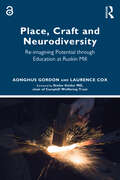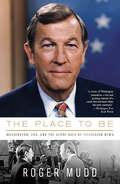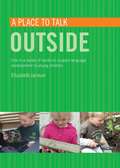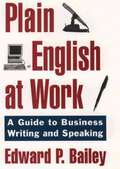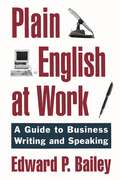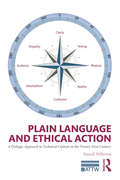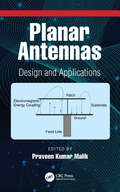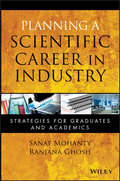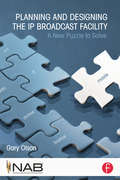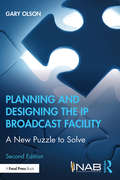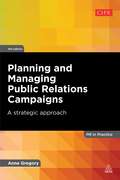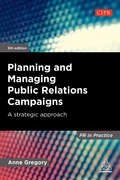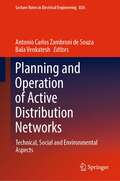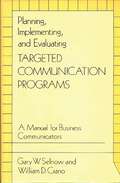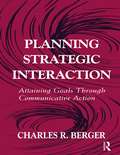- Table View
- List View
Place, Craft and Neurodiversity: Re-imagining Potential through Education at Ruskin Mill
by Aonghus Gordon Laurence CoxFor over four decades, Ruskin Mill Trust has worked with young people with special educational needs and behavioural issues who learn traditional crafts and organic farming as part of an integrated curriculum of therapeutic education, overcoming barriers to learning and re-engaging with the wider world. This accessible and inspiring book showcases how an appreciation of place, traditional crafts, farming and transformative education offers a wider route to human well-being for all. The authors outline the different fields of the “Practical Skills Therapeutic Education” method, which includes developing practical skills, learning the ecology of the farm and understanding therapeutic education, holistic care, health and self-leadership. Taking the reader on a tour of Ruskin Mill’s many extraordinary provisions across Britain, and going deeper in conversation with its founder, Aonghus Gordon, this book is an outstanding story of creative thinking in an age of narrow focus on classrooms and written examinations, presenting a transformative perspective on education and care. Being grounded in work supporting young people with complex additional needs, it provides a rare insight into the work of one of the world’s leading charities working with neurodiversity. With its non-specialist language, Place, Craft and Neurodiversity offers ideas and resources for work in different areas of education and therapy. It will inspire parents, educators and care workers around the globe.
Place, Craft and Neurodiversity: Re-imagining Potential through Education at Ruskin Mill
by Aonghus Gordon Laurence CoxFor over four decades, Ruskin Mill Trust has worked with young people with special educational needs and behavioural issues who learn traditional crafts and organic farming as part of an integrated curriculum of therapeutic education, overcoming barriers to learning and re-engaging with the wider world. This accessible and inspiring book showcases how an appreciation of place, traditional crafts, farming and transformative education offers a wider route to human well-being for all. The authors outline the different fields of the “Practical Skills Therapeutic Education” method, which includes developing practical skills, learning the ecology of the farm and understanding therapeutic education, holistic care, health and self-leadership. Taking the reader on a tour of Ruskin Mill’s many extraordinary provisions across Britain, and going deeper in conversation with its founder, Aonghus Gordon, this book is an outstanding story of creative thinking in an age of narrow focus on classrooms and written examinations, presenting a transformative perspective on education and care. Being grounded in work supporting young people with complex additional needs, it provides a rare insight into the work of one of the world’s leading charities working with neurodiversity. With its non-specialist language, Place, Craft and Neurodiversity offers ideas and resources for work in different areas of education and therapy. It will inspire parents, educators and care workers around the globe.
The Place to Be: Washington, CBS, and the Glory Days of Television News
by Roger MuddRoger Mudd joined CBS in 1961, and as the congressional correspondent, became a star covering the historic Senate filibuster debate over the 1964 Civil Right Act. Mudd was one of half a dozen major figures in the stable of CBS News broadcasters at time when the network's standing as a provider of news was at its peak. In The Place to Be, Mudd tells of how the bureau worked: the rivalries, the egos, the pride, the competition, the ambitions and the gathering frustrations of conveying the world to a national television audience in thirty minutes minus commercials. It is the story of a unique TV news bureau, unmatched in its quality, dedication, and professionalism, that will highlight what TV journalism was once like and what it's missing today.
The Place to Be: Washington, CBS, and the Glory Days of Television News
by Roger MuddRoger Mudd joined CBS in 1961, and as the congressional correspondent, became a star covering the historic Senate debate over the 1964 Civil Right Act. Appearing at the steps of Congress every morning, noon, and night for the twelve weeks of filibuster, he established a reputation as a leading political reporter. Mudd was one of half a dozen major figures in the stable of CBS News broadcasters at a time when the network's standing as a provider of news was at its peak. In The Place to Be, Mudd tells of how the bureau worked: the rivalries, the egos, the pride, the competition, the ambitions, and the gathering frustrations of conveying the world to a national television audient in thirty minutes minus commercials. It is the story of a unique TV news bureau, unmatched in its quality, dedication, and professionalism. It shows what TV journalism was once like and what it's missing today.
A Place To Talk Outside (PDF)
by Elizabeth JarmanThis series considers the significant role that the physical environment can play in supporting children's speaking and listening skills. The books provide guidance on assessing and improving environments for speaking and listening.
The Plain English Approach to Business Writing
by Edward P. BaileyIn offices across America, the Masters of Gobbledygook are hard at work. They're bombarding in-boxes with those long, confusing memos that colleagues don't have the patience to read--and bosses don't have the time to rewrite. They use words like "commence" or "prior to" instead of "begin" or "before." They bury their main point somewhere in the last paragraph--and take two pages to get there. Everybody knows one of them; in fact, you may even be one of them. But now there's help for anyone who's ever fallen prey to businessese, academese, legalese, or any other "ese" when faced with a blank memo pad. In The Plain English Approach to Business Writing, Edward Bailey--who spent twenty years working in the bastions of bureaucratese--offers readers a powerful new communications tool. Written for busy professionals who want to improve the quality and clarity of their own (or their staff's) writing style, this no-nonsense guide is an indispensable office companion. Bailey's approach is 5urprisingly straightforward: just write as you would talk. Plain English is not only easier to read; it's also easier to write. And it's so effective that many large organizations are endorsing, if not demanding, its use in the work place. Pithy and entertaining, Bailey points out all the dos and don'ts of plain English. He then illustrates them with examples drawn from a wide array of sources, including business documents, technical manuals, trade publications like Consumer Reports, and the works of writers such as Russell Baker and John D. MacDonald. From the basics to the fine tuning, he offers practical advice on clarity and precision, organization, layout, and a host of other important writing topics. A delightful, down-to-earth guide, The Plain English Approach to Business Writing is for professionals of all backgrounds (government, military, legal, financial, technical, corporate) and staff at all levels (from the company CEO to the ambitious secretary). The Plain English Approach to Business Writing can be read in an hour--and used for the rest of one's life.
The Plain English Approach to Business Writing
by Edward P. BaileyIn offices across America, the Masters of Gobbledygook are hard at work. They're bombarding in-boxes with those long, confusing memos that colleagues don't have the patience to read--and bosses don't have the time to rewrite. They use words like "commence" or "prior to" instead of "begin" or "before." They bury their main point somewhere in the last paragraph--and take two pages to get there. Everybody knows one of them; in fact, you may even be one of them. But now there's help for anyone who's ever fallen prey to businessese, academese, legalese, or any other "ese" when faced with a blank memo pad. In The Plain English Approach to Business Writing, Edward Bailey--who spent twenty years working in the bastions of bureaucratese--offers readers a powerful new communications tool. Written for busy professionals who want to improve the quality and clarity of their own (or their staff's) writing style, this no-nonsense guide is an indispensable office companion. Bailey's approach is 5urprisingly straightforward: just write as you would talk. Plain English is not only easier to read; it's also easier to write. And it's so effective that many large organizations are endorsing, if not demanding, its use in the work place. Pithy and entertaining, Bailey points out all the dos and don'ts of plain English. He then illustrates them with examples drawn from a wide array of sources, including business documents, technical manuals, trade publications like Consumer Reports, and the works of writers such as Russell Baker and John D. MacDonald. From the basics to the fine tuning, he offers practical advice on clarity and precision, organization, layout, and a host of other important writing topics. A delightful, down-to-earth guide, The Plain English Approach to Business Writing is for professionals of all backgrounds (government, military, legal, financial, technical, corporate) and staff at all levels (from the company CEO to the ambitious secretary). The Plain English Approach to Business Writing can be read in an hour--and used for the rest of one's life.
Plain English at Work: A Guide to Writing and Speaking
by Edward P. BaileyEveryday we write countless memos, letters, and reports without a second thought. Likewise, we give presentations, both formal and informal. Often this writing and speaking gets criticized for being jargon-ridden, obscure, or long-winded--in short, for not being in "plain English." But what is plain English, and how do we go about writing and speaking it? In Plain English at Work, Edward Bailey gives the answer, with down-to-earth tips and practical advice. Bailey, an expert in business communication, gives us a simple model for writing: BL Style: write more the way you talk. BL Organization: make your point easy to find. BL Layout: use headings, lists, and other white space so readers can see the structure of your writing. Psycholinguists, Bailey points out, have proven that the techniques of plain English writing are far easier on your readers; experience has proven that writing in plain English is easier on you--the writer, too. Bailey also gives you a wealth of practical advice for presentations including: BL How to remember your talk. BL How to design visual aids. BL How to design computer presentations. BL How to set up the room you'll be speaking in. BL How to develop a successful delivery style. Perhaps most impressive are the many detailed tips he gives here. For instance, when using a pointer, hold it in the hand closer to the screen (otherwise, you turn your back on the audience, making it harder to hear you). When designing a visual aid, use at least 28-point type, and seldom use all capital letters (which are harder to read). And when presenting a bar chart during a computer presentation, build it--a bar at a time--to focus your audience's attention. Drawing on two earlier and popular books, The Plain English Approach to Business Writing and A Practical Guide for Business Speaking, this new volume has been significantly updated. It includes up-to-the-minute information on using computers, computer graphics, and typography for your writing, and on using the same technology for designing your presentations. The result is an authoritative and comprehensive single volume that will be the essential guide for everyone wishing to communicate more easily and effectively at work.
Plain Language and Ethical Action: A Dialogic Approach to Technical Content in the 21st Century (ATTW Series in Technical and Professional Communication)
by Russell WillertonPlain Language and Ethical Action examines and evaluates principles and practices of plain language that technical content producers can apply to meet their audiences’ needs in an ethical way. Applying the BUROC framework (Bureaucratic, Unfamiliar, Rights-Oriented, and Critical) to identify situations in which audiences will benefit from plain language, this work offers in-depth profiles show how six organizations produce effective plain-language content. The profiles show plain-language projects done by organizations ranging from grassroots volunteers on a shoe-string budget, to small nonprofits, to consultants completing significant federal contacts. End-of-chapter questions and exercises provide tools for students and practitioners to reflect on and apply insights from the book. Reflecting global commitments to plain language, this volume includes a case study of a European group based in Sweden along with results from interviews with plain-language experts around the world, including Canada, England, South Africa. Portugal, Australia, and New Zealand. This work is intended for use in courses in information design, technical and professional communication, health communication, and other areas producing plain language communication. It is also a crucial resource for practitioners developing plain-language technical content and content strategists in a variety of fields, including health literacy, technical communication, and information design.
Plain Language and Ethical Action: A Dialogic Approach to Technical Content in the 21st Century (ATTW Series in Technical and Professional Communication)
by Russell WillertonPlain Language and Ethical Action examines and evaluates principles and practices of plain language that technical content producers can apply to meet their audiences’ needs in an ethical way. Applying the BUROC framework (Bureaucratic, Unfamiliar, Rights-Oriented, and Critical) to identify situations in which audiences will benefit from plain language, this work offers in-depth profiles show how six organizations produce effective plain-language content. The profiles show plain-language projects done by organizations ranging from grassroots volunteers on a shoe-string budget, to small nonprofits, to consultants completing significant federal contacts. End-of-chapter questions and exercises provide tools for students and practitioners to reflect on and apply insights from the book. Reflecting global commitments to plain language, this volume includes a case study of a European group based in Sweden along with results from interviews with plain-language experts around the world, including Canada, England, South Africa. Portugal, Australia, and New Zealand. This work is intended for use in courses in information design, technical and professional communication, health communication, and other areas producing plain language communication. It is also a crucial resource for practitioners developing plain-language technical content and content strategists in a variety of fields, including health literacy, technical communication, and information design.
Planar Antennas: Design and Applications
by Praveen Kumar MalikThis comprehensive reference text discusses fundamental concepts, applications, design techniques, and challenges in the field of planar antennas. The text focuses on recent advances in the field of planar antenna design and their applications in various fields of research, including space communication, mobile communication, wireless communication, and wearable applications. This resource presents planar antenna design concepts, methods, and techniques to enhance the performance parameters and applications for IoTs and device-to-device communication. The latest techniques used in antenna design, including their structures defected ground, MIMO, and fractal design, are discussed comprehensively. The text will be useful for senior undergraduate students, graduate students, and academic researchers in fields including electrical engineering, electronics, and communication engineering.
Planar Antennas: Design and Applications
by Praveen Kumar MalikThis comprehensive reference text discusses fundamental concepts, applications, design techniques, and challenges in the field of planar antennas. The text focuses on recent advances in the field of planar antenna design and their applications in various fields of research, including space communication, mobile communication, wireless communication, and wearable applications. This resource presents planar antenna design concepts, methods, and techniques to enhance the performance parameters and applications for IoTs and device-to-device communication. The latest techniques used in antenna design, including their structures defected ground, MIMO, and fractal design, are discussed comprehensively. The text will be useful for senior undergraduate students, graduate students, and academic researchers in fields including electrical engineering, electronics, and communication engineering.
Planning a Scientific Career in Industry: Strategies for Graduates and Academics
by Sanat Mohanty Ranjana GhoshA handy guide for students seeking a scientific career in industry When choosing a career in industry, many of today's graduates with degrees in science and technology don't know exactly what they are looking for, the options they have available, how to position themselves to achieve their goals, or even how to define their own meanings of success. By addressing each of these issues, Planning a Scientific Career in Industry covers material not found in school textbooks or career guides to show what makes an industry tick, then demonstrates how this knowledge can be used to gain fresh perspective and open new career doors. This book: Provides unique insight for new graduates on the technology sector Offers tools of the trade that can be used by the graduate to make decisions on the job Defines how to understand the DNA of an organization, the nature and viability of career choices, and the value of specific skills With the backing of authors who have distinguished themselves in industry, this book presents a variety of techniques and applications, along with sound guidelines, that help chart a career course filled with rewarding opportunities—both personally and professionally.
Planning and Designing the IP Broadcast Facility: A New Puzzle to Solve
by Gary OlsonThe transition to computer-based technologies and file-based workflows is one of the most significant changes the broadcast and production industry has seen. Media is produced for multiple delivery platforms: Over the Air, Over the Top, large screen displays, cable, satellite, web, digital signage, tablets, and smartphones. These changes impact all aspects of creation, production, media management, technical operations, business processes, and distribution to end users. Of all the books and papers discussing storage mapping, packet transport, and compression algorithms, none puts all the pieces together and explains where these fit into the whole environment. Planning and Designing the IP Broadcast Facility is the first to provide a comprehensive understanding of the technology architecture, physical facility changes, and—most importantly—the new media management workflows and business processes to support the entire lifecycle of the IP broadcast facility from an engineering and workflow perspective. Key features: This beginning-to-end perspective gives you the necessary knowledge to make the decisions to implement a cost-effective file-based production and distribution system. The cohesive, big-picture viewpoint helps you identify the differences in a tape-based facility, then how to overcome the unique challenges of upgrading your plant. Case studies throughout the book serve as recommendations and examples of use, helping you weigh the pros and cons of various approaches.
Planning and Designing the IP Broadcast Facility: A New Puzzle to Solve
by Gary OlsonThe transition to computer-based technologies and file-based workflows is one of the most significant changes the broadcast and production industry has seen. Media is produced for multiple delivery platforms: Over the Air, Over the Top, large screen displays, cable, satellite, web, digital signage, tablets, and smartphones. These changes impact all aspects of creation, production, media management, technical operations, business processes, and distribution to end users. Of all the books and papers discussing storage mapping, packet transport, and compression algorithms, none puts all the pieces together and explains where these fit into the whole environment. Planning and Designing the IP Broadcast Facility is the first to provide a comprehensive understanding of the technology architecture, physical facility changes, and—most importantly—the new media management workflows and business processes to support the entire lifecycle of the IP broadcast facility from an engineering and workflow perspective. Key features: This beginning-to-end perspective gives you the necessary knowledge to make the decisions to implement a cost-effective file-based production and distribution system. The cohesive, big-picture viewpoint helps you identify the differences in a tape-based facility, then how to overcome the unique challenges of upgrading your plant. Case studies throughout the book serve as recommendations and examples of use, helping you weigh the pros and cons of various approaches.
Planning and Designing the IP Broadcast Facility: A New Puzzle to Solve
by Gary OlsonThis book provides a comprehensive understanding of the technology architecture, physical facility changes and – most importantly – the new media management workflows and business processes to support the entire lifecycle of the IP broadcast facility from an engineering and workflow perspective. Fully updated, this second edition covers the technological evolutions and changes in the media broadcast industry, including the new standards and specifications for live IP production, the SMPTE ST2110 suite of standards, the necessity of protecting against cyber threats and the expansion of cloud services in opening new possibilities. It provides users with the necessary information for planning, organizing, producing and distributing media for the modern broadcast facility. Key features of this text include: Strategies to implement a cost-effective live and file-based production and distribution system. A cohesive, big-picture viewpoint that helps you identify how to overcome the challenges of upgrading your plant. The impact live production is having on the evolution to IP. Case studies serve as recommendations and examples of use. New considerations in engineering and maintenance of IP and file-based systems. Those in the fields of TV, cable, IT engineering and broadcast engineering will find this book an invaluable resource, as will students learning how to set up modern broadcast facilities and the workflows of contemporary broadcasting.
Planning and Designing the IP Broadcast Facility: A New Puzzle to Solve
by Gary OlsonThis book provides a comprehensive understanding of the technology architecture, physical facility changes and – most importantly – the new media management workflows and business processes to support the entire lifecycle of the IP broadcast facility from an engineering and workflow perspective. Fully updated, this second edition covers the technological evolutions and changes in the media broadcast industry, including the new standards and specifications for live IP production, the SMPTE ST2110 suite of standards, the necessity of protecting against cyber threats and the expansion of cloud services in opening new possibilities. It provides users with the necessary information for planning, organizing, producing and distributing media for the modern broadcast facility. Key features of this text include: Strategies to implement a cost-effective live and file-based production and distribution system. A cohesive, big-picture viewpoint that helps you identify how to overcome the challenges of upgrading your plant. The impact live production is having on the evolution to IP. Case studies serve as recommendations and examples of use. New considerations in engineering and maintenance of IP and file-based systems. Those in the fields of TV, cable, IT engineering and broadcast engineering will find this book an invaluable resource, as will students learning how to set up modern broadcast facilities and the workflows of contemporary broadcasting.
Planning and Managing Public Relations Campaigns: A Strategic Approach (4th edition)
by Anne GregoryGetting a public relations campaign or programme off the ground can seem overwhelming. Planning and Managing Public Relations Campaigns provides a blueprint for all practitioners. Practical and easy to read, the book presents a 12-point plan for ensuring success of campaigns of all sizes, covering many vital areas including the role of public relations in organizations, the importance of context, research and analysis, setting objectives, strategy and tactics, timescales and resources, evaluation and review. Planning and Managing Public Relations Campaigns is widely regarded as one of the best 'how-to' guides for students and practitioners. This fully updated fourth edition features new developments in public relations, including social media, along with new case studies including WRAP's Love Food, Hate Waste campaign; The Sleep Pod Hotel Media Tour; McArthur River Mining; AkzoNobel's Corporate Revolution; the UK Department of Culture, Media amp; Sport's First World War Centenary Commemorations; and Lanson's campaign for unbiased.co.uk. About the PR in Practice series: Published in collaboration with the Chartered Institute of Public Relations (CIPR), the PR in Practice series consists of accessible, practical introductions to day-to-day public relations practice and management issues. The series' action-oriented approach keeps practitioners' knowledge and skills up to date.
Planning and Managing Public Relations Campaigns: A Strategic Approach (4th edition)
by Anne GregoryGetting a public relations campaign or programme off the ground can seem overwhelming. Planning and Managing Public Relations Campaigns provides a blueprint for all practitioners. Practical and easy to read, the book presents a 12-point plan for ensuring success of campaigns of all sizes, covering many vital areas including the role of public relations in organizations, the importance of context, research and analysis, setting objectives, strategy and tactics, timescales and resources, evaluation and review. Planning and Managing Public Relations Campaigns is widely regarded as one of the best 'how-to' guides for students and practitioners. This fully updated fourth edition features new developments in public relations, including social media, along with new case studies including WRAP's Love Food, Hate Waste campaign; The Sleep Pod Hotel Media Tour; McArthur River Mining; AkzoNobel's Corporate Revolution; the UK Department of Culture, Media amp; Sport's First World War Centenary Commemorations; and Lanson's campaign for unbiased.co.uk. About the PR in Practice series: Published in collaboration with the Chartered Institute of Public Relations (CIPR), the PR in Practice series consists of accessible, practical introductions to day-to-day public relations practice and management issues. The series' action-oriented approach keeps practitioners' knowledge and skills up to date.
Planning and Managing Public Relations Campaigns: A Strategic Approach (Pr In Practice Ser.)
by Anne GregoryTaking a public relations campaign from planning through to implementation can seem overwhelming. Planning and Managing Public Relations Campaigns provides a blueprint for success, and is widely regarded as one of the best 'how-to' guides for students and practitioners. Digestible and easy to read, this fifth edition presents a 12-point plan for ensuring success of campaigns of all sizes, covering vital areas including the role of public relations in organizations, the importance of context, research and analysis, setting objectives, strategy and tactics, timescales and resources, evaluation and review.With discussion of new developments in the industry, from the gig economy and online influencers, to disruptive models, this fully updated new edition addresses the need for agile planning and draws on fresh case studies to provide up-to-date examples of best practice. Supported by a suite of online resources, Planning and Managing Public Relations Campaigns is an invaluable guide for students and practitioners alike. Online resources include extended case studies, lecture slides, discussion questions and assessment tasks.
Planning and Managing Public Relations Campaigns: A Strategic Approach
by Anne GregoryTaking a public relations campaign from planning through to implementation can seem overwhelming. Planning and Managing Public Relations Campaigns provides a blueprint for success, and is widely regarded as one of the best 'how-to' guides for students and practitioners. Digestible and easy to read, this fifth edition presents a 12-point plan for ensuring success of campaigns of all sizes, covering vital areas including the role of public relations in organizations, the importance of context, research and analysis, setting objectives, strategy and tactics, timescales and resources, evaluation and review.With discussion of new developments in the industry, from the gig economy and online influencers, to disruptive models, this fully updated new edition addresses the need for agile planning and draws on fresh case studies to provide up-to-date examples of best practice. Supported by a suite of online resources, Planning and Managing Public Relations Campaigns is an invaluable guide for students and practitioners alike. Online resources include extended case studies, lecture slides, discussion questions and assessment tasks.
Planning and Operation of Active Distribution Networks: Technical, Social and Environmental Aspects (Lecture Notes in Electrical Engineering #826)
by Antonio Carlos Zambroni de Souza Bala VenkateshThis book offers a broad and detailed view about how traditional distribution systems are evolving smart/active systems. The reader will be able to share the view of a number of researchers directly involved in this field. For this sake, philosophical discussions are enriched by the presentation of theoretical and computational tools. A senior reader may incorporate some concepts not available during his/her graduation process, whereas new Engineers may have contact with some material that may be essential to his/her practice as professionals.
Planning, Implementing, and Evaluating Targeted Communication Programs: A Manual for Business Communicators
by William D. Crano Gary W. SelnowThis book is well documented, well written, well researched and is up-to-date. It is non-sexist. It is more than a `manual for business communicators.' It is more than a book of `how to's.' And it is more than a book of do's and don'ts. The authors and contributors skillfully draw upon a broad range of social sciences literature and their personal communication experience, both of which make this book invaluable in our understanding of the relationship between communication theory and practice. Beyond that, they offer clear guidelines for effective public communication. Public Relations ReviewThis book discusses the strategy of targeted communication and explains the steps necessary to plan and implement an effective information program. Selnow and Crano both place their recommendations in a communication theory and research perspective and show them to have practical application in real-world programs. They deal not only with the how to's, but with the why's as well.
Planning Strategic Interaction: Attaining Goals Through Communicative Action (Routledge Communication Ser.)
by Charles R. BergerIn an earlier era, the communication field was dominated by the study of mediated and unmediated message effects during which considerable research focused on the attitudinal and action consequences of exposure to messages. A more catholic purview of the communication process exists today. This more encompassing perspective does not deny the importance of studying message effects, but raises the additional question of how individuals generate messages in the first place. While the earlier era of communication research was dominated by studies that focused on attitude and behavior change as primary dependent variables, such variables as message comprehension have begun to emerge in this new era. The focus on communication and cognition has led, paradoxically, to a more intense focus on social interaction processes. The theory and research presented in this volume seeks to strike a balance between the internal workings of the individual cognitive system on the one hand and the outer world of social interaction on the other. Whether or not the theory and research stands the test of time, it is clear that complete cognitive accounts of social interaction cannot confine themselves to mere descriptions of the cognitive structures and processes that are responsible for message production and comprehension. Explicit links must be made between these cognitive structures and processes and the workings of social interaction. This work takes a modest step in that direction.
Planning Strategic Interaction: Attaining Goals Through Communicative Action
by Charles R. BergerIn an earlier era, the communication field was dominated by the study of mediated and unmediated message effects during which considerable research focused on the attitudinal and action consequences of exposure to messages. A more catholic purview of the communication process exists today. This more encompassing perspective does not deny the importance of studying message effects, but raises the additional question of how individuals generate messages in the first place. While the earlier era of communication research was dominated by studies that focused on attitude and behavior change as primary dependent variables, such variables as message comprehension have begun to emerge in this new era. The focus on communication and cognition has led, paradoxically, to a more intense focus on social interaction processes. The theory and research presented in this volume seeks to strike a balance between the internal workings of the individual cognitive system on the one hand and the outer world of social interaction on the other. Whether or not the theory and research stands the test of time, it is clear that complete cognitive accounts of social interaction cannot confine themselves to mere descriptions of the cognitive structures and processes that are responsible for message production and comprehension. Explicit links must be made between these cognitive structures and processes and the workings of social interaction. This work takes a modest step in that direction.
